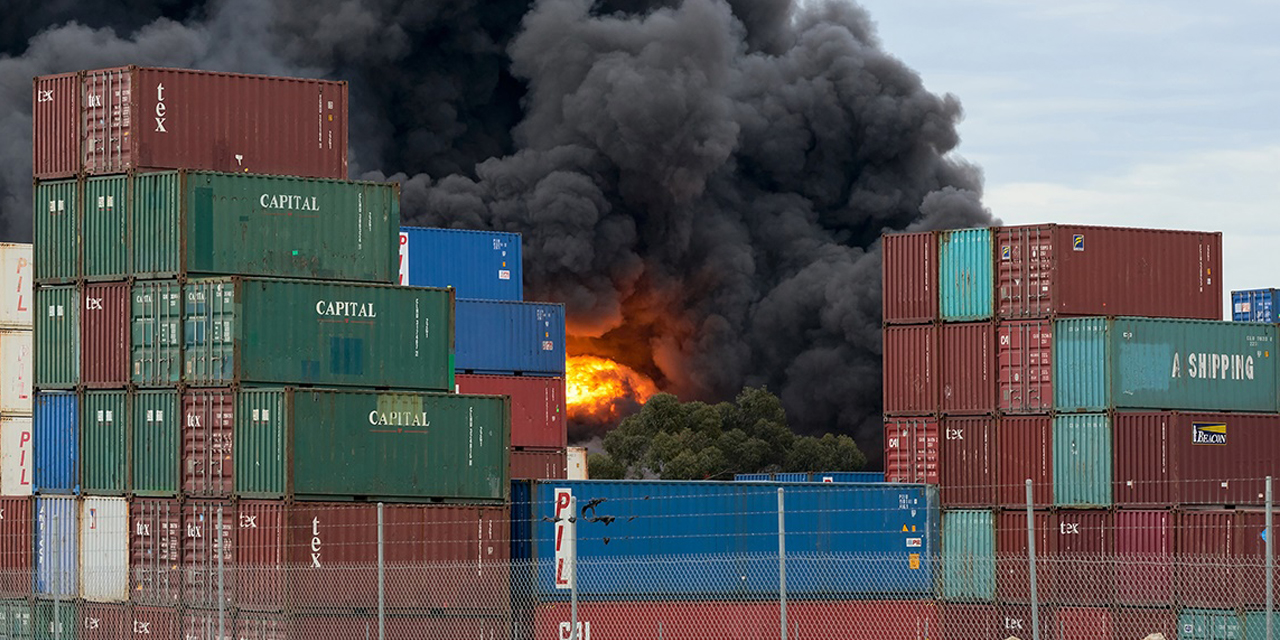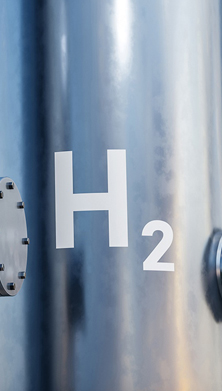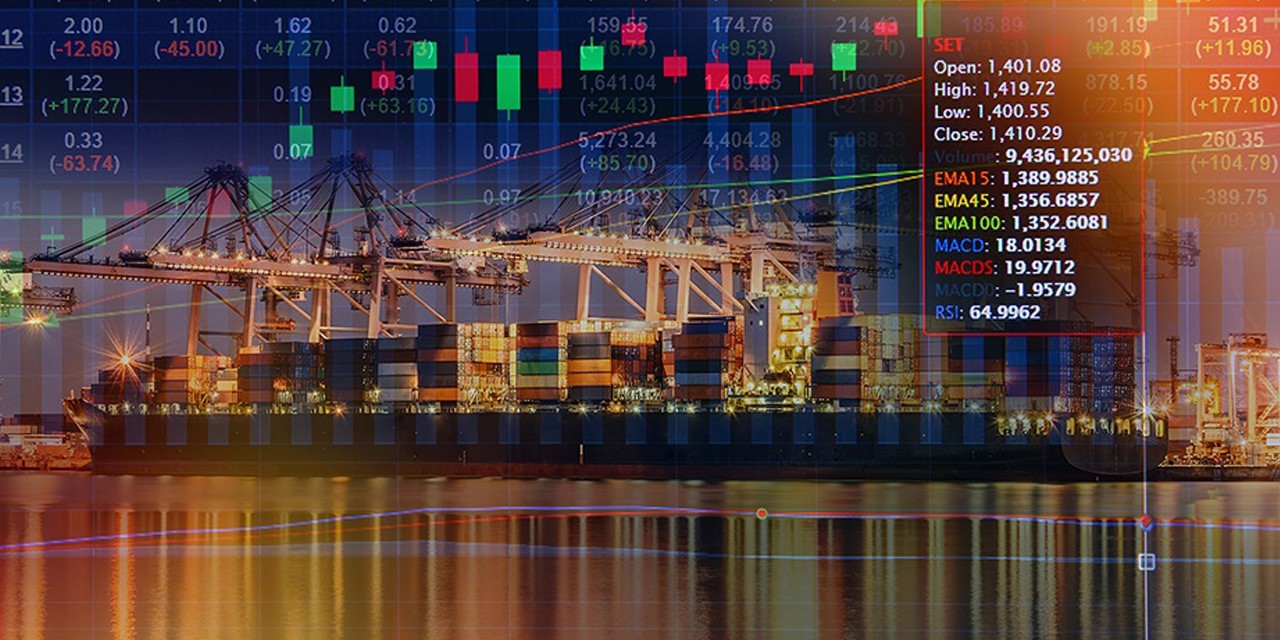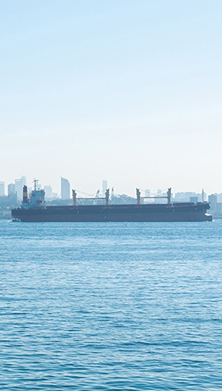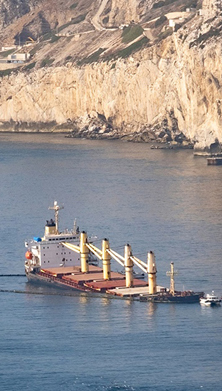This article is part of the
Safety and Shipping Review 2023
Cargo fire risks continue to rise
Hazardous and combustible goods are increasingly transported by containers, while the prevalence of Lithium-ion (Li-ion) batteries poses a growing risk for both container shipping and car carrier vessels. At the same time, these hazardous cargos are increasingly transported by large vessels, where the consequences of fires are amplified, resulting in more severe losses and longer delays.
“Decarbonization is leading to new types of cargo, some more hazardous than in the past, such as electric scooters and battery-powered goods,” says Captain Rahul Khanna, Global Head of Marine Risk Consulting at Allianz Global Corporate & Specialty (AGCS).
“A lot of conventional power sources have been replaced by batteries, and that industry has seen huge increases in demand in recent years, a trend that will only continue. These new cargos mean new risks,” says Khanna.
Fire is one of the the biggest causes of general average claims on container vessels, and one of the main causes of total losses across all vessel types with 64 ships lost in the past five years alone. With upwards of 20,000 containers on board some vessels, the risk of a fire originating from a container increase, while detecting and fighting a fire at sea is particularly difficult for a crew of just 20 to 30 people, according to Marcel Ackermann, Global Project Leader Cargo at AGCS. A small container fire can easily take hold and overwhelm the ability of crew to deal with the situation, leading to the abandonment of the vessel, and potentially its loss.
Recent incidents include the ZIM Charleston fire in August 2022, in which some 300 containers were reportedly damaged. [1] This was followed by the TSS Pearl in the Red Sea in October 2022, [2] which sank after the crew were forced to abandon ship. There have also been several fires at ports and warehouses, including the 2022 fire and explosion [3] at a container depot in Chittagong, Bangladesh, which killed 40 people.
“General average has a significant impact on cargo customers because if it occurs, the time it takes to release cargo is exponentially longer on a large container vessel, which has implications for supply chains and seasonal cargo,” says Ackermann.
“When we look at significant general average incidents involving container vessels over the past five years, they are largely related to fires. General average risk these days comes down to fire, and the majority of these incidents are related to mis-declaration of cargo.”
What is general average?
Addressing the root cause of fires - mis-declared cargo
In recent years the role that mis-declared dangerous goods, such as chemicals, batteries and charcoal, have played in cargo fires has become increasingly documented. Failure to properly declare, document and pack such hazardous cargo can result in containers stowed inappropriately, or hamper firefighting efforts. Labeling a cargo as dangerous is more expensive and therefore some companies try to circumvent this by labeling items such as fireworks as toys or lithium-ion batteries as computer parts for example.
Meanwhile, the Cargo Incident Notification System (CINS) [4] says nearly 25% of all serious incidents onboard container ships are attributable to mis-declared cargo. In 2020, a US National Cargo Bureau (NCB) survey [5] focusing on 500 containers showed that more than half failed with one or more deficiencies, 69% of the import containers contained dangerous goods and 38% of the export ones. Of the import containers with dangerous goods, 44% had problems with the way cargo was secured, 39% had improper placarding and 8% had mis-declared cargo. Of the export containers with dangerous goods, 25% had securing issues, 15% were improperly placarded and 5% were mis‑declared.
A number of large container shipping companies have turned to technology to address mis-declared cargo, using cargo screening software – like the US National Cargo Bureau’s Hazcheck Detect [6] tool – to detect suspicious bookings and cargo details. Several large container operators are now imposing penalties on mis-declared dangerous goods.
“Mis-declared cargo is an important factor in many container fires, but no real holistic solution to this problem is in sight. Currently, each shipping company and jurisdiction has its own requirements while the rate of container inspections in many countries is low,” says Marcel Ackermann, Global Product Leader Cargo at AGCS.
“The challenge is how to regulate a global industry in which millions of diversified containers are transported every year. What we would really like to see is unified requirements for mis-declared hazardous cargo on all shippers and fines for those that mis-declare hazardous cargo,” says Captain Rahul Khanna, Global Head of Marine Risk Consulting at AGCS.
Addressing the risks from Li-ion batteries

Decarbonization and electrification are increasing the number of shipping goods that contain Li-ion batteries, from electric vehicles to a wide range of consumer and electronic goods. The global Li-ion battery market is expected to grow by over 30% annually from 2022 to 2030, according to McKinsey. [7] The number of electric vehicles (EVs) is also growing at a fast pace: Nearly 10% [8] of global car sales were electric in 2021, four times the market share in 2019.
The main hazards of Li-ion batteries are fire, explosion, and ‘thermal runaway’, a rapid self-heating fire that can cause an explosion. They can also produce irritating, corrosive or poisonous gases that cause an explosion in a confined space. The main causes of Li-ion fires are substandard manufacturing or damaged battery cells or devices, over-charging, and short circuiting.
Fires in EVs with Li-ion batteries can burn more ferociously, are very difficult to extinguish, and are capable of spontaneously reigniting hours or even days after they have been put out. Most ships lack the suitable fire protection, firefighting capabilities, and detection systems to tackle such fires at sea, which has been made more difficult by the dramatic increase in ship size.
“Li-ion batteries on their own are not new, and the risks are well documented,” says Captain Randall Lund, Senior Marine Risk Consultant at Allianz Global Corporate & Specialty (AGCS). “But the explosion of demand for these batteries is flooding the market with new manufacturers, raising questions around quality control. We have seen many fires where the cause has been traced to malfunctioning or damaged batteries.”
Li-ion fire risks will likely ease over time as manufacturers, carriers, and regulators address the current challenges. In the meantime, attention must be focused on pre-emptive measures to help mitigate the peril. Measures to consider include ensuring staff/crew receive adequate training and access to appropriate firefighting equipment, improving early detection systems and developing hazard control and emergency plans.
“The debate about electric vehicles in the shipping industry is ongoing, with conversations about whether there is a need for dedicated Ro-ro vessels for EVs. From an insurance perspective, this is something we would like to see – purpose built vessels for transporting electric vehicles, designed to substantially reduce the risk of fire,” says Captain Rahul Khanna, Global Head of Marine Risk Consulting at AGCS.
When it comes to concrete actions to mitigate battery fire risk in containers and on Ro-Ros, there is no clear universal solution as yet, says Justus Heinrich, Global Product Leader Marine Hull at AGCS: “If this risk is not properly mitigated, insurers will have to address it through portfolio risk management and insurance capacity steering.”
Making progress on container ship fire safety
For almost a decade Allianz Global Corporate & Specialty (AGCS) and others in the insurance industry have called for enhanced fire detection and fighting systems for container ships. In 2017, the International Union of Marine Insurance (IUMI) co-sponsored a submission to the International Maritime Organization (IMO) Maritime Safety Committee with a view to amending The International Convention for the Safety of Life at Sea (SOLAS) to enhance provisions for early fire detection and effective control of fires in containerized cargos. Although delayed by Covid-19, the process to amend SOLAS is underway.
In March 2023, the European Maritime Safety Agency published its CARGOSAFE study, [9] which assesses the risks associated with fires on container ships and evaluates prevention, detection, firefighting, and containment measures. The IMO is to review the study, alongside other industry and insurer proposals to improve the firefighting capability for the cargo deck area of container ships. The amendments to SOLAS, which apply to new ships, are expected to enter into force on January 1, 2028.
In addition to the IMO work, the private sector has been developing technical solutions to the problem, such as using sensors and thermal imaging to detect fires early. In another positive development, a group of leading shipping companies [10] launched the Cargo Fire & Loss Innovation Initiative, which aims to reduce the impact of cargo fires and cargo loss through joint requirements, technology solutions, and best practices and recommendations.
“We are seeing innovation in the private sector to address the issue of fires on container ships, and inside containers, which makes us optimistic that realization of the problem has increased. This is no longer about raising awareness but moving to concrete measures through investment in fire detection and protection for existing vessels, in combination with discussions at IMO level on new ship design,” says Captain Rahul Khanna, Global Head of Marine Risk Consulting at AGCS.
Containers overboard
New regulations will require operators to keep track of shipping containers lost at sea, which pose a threat to navigation and the environment.
In March, 2023, an MSC container ship [11] lost 46 empty shipping containers at three different times during bad weather east of Bermuda. The incident followed one of the worst periods on record for container losses. According to the World Shipping Council [12] (WSC), over 3,100 containers were lost for the two-year period 2020-2021, more than four times the 779 reported in the previous period.
Last year, the International Maritime Organization (IMO) agreed proposals for the mandatory reporting of lost containers. The draft amendments to the International Convention for the Safety of Life at Sea (SOLAS) and the International Convention for the Prevention of Pollution from Ships (MARPOL) treaties will require vessels to report the loss of freight containers without delay to ships in the vicinity, and to the nearest coastal state and flag state. The draft amendments are expected to enter into force on January 1, 2026. “Shipowners will be required to trace container losses at sea in order to recover them. It is no longer acceptable that a vessel can easily lose containers which are a danger to navigation and a threat to the environment,” says Régis Broudin, Global Head of Marine Claims at Allianz Global Corporate & Specialty.
“There were fewer incidents in 2022, but this remains an important issue for the container industry, in particular large container ships, where the size of vessels may be a factor in the loss of containers in heavy seas,” says Broudin. Large container vessels, where containers can be stacked as many as 26 deep, are vulnerable to parametric rolling (extreme rolling and pitching) in certain sea conditions, exerting extreme stresses on container stacks and their securing systems.
“We cannot stop stronger weather conditions at sea. But we can address the risk of human error with storage and lashing of containers,” says Broudin.
Erosion of specialist skills leads to project cargo losses
In January 2023, a 375-ton column broke free and fell off the deck of a bulk carrier into the Adriatic Sea near Italy. Both the shipping company and the vessel were not specialist project cargo carriers. This is not the only such incident seen by insurers in recent years.
Critical project cargo is typically high value, with long lead times, explains Captain Rahul Khanna, Global Head of Marine Risk Consulting at Allianz Global Corporate & Specialty (AGCS): “Values can range from under $1mn to tens of millions of dollars, but delay in start-up claims can be many times the value of the cargo. A damaged turbine could take 12 to 18 months to replace, for example.”
The project cargo market has seen increased activity since the Covid-19 pandemic, with growing demand from increasing investment in infrastructure development and the decarbonization of industries. However, handling critical cargo requires specialist vessels, equipment, and port infrastructure. Being heavy and cumbersome, it also relies on skilled personnel and robust procedures to load and transport project cargo safely.
“The specialist skills and vessels required to transport project cargo are in high demand as the number of such items has increased since the pandemic. But there is concern in the insurance industry that the specialist skills required to load and transport project cargo are slowly eroding,” says Khanna.
“We are experiencing an increase in losses, and we need to see a tightening up of processes and procedures. Ships and crews and levels of training should be of the highest level when handling critical cargo. It is important they are not carried on non-specialist ships with crews that are not trained for heavy lift vessels.
“Many of the losses are caused by a poor understanding of procedures to load and stow project cargo. Damage typically happens due to usage of inadequate lifting equipment or poor cargo securing arrangements. It is therefore imperative that experienced personnel are in charge of such operations and marine warranty surveyors are appointed,” says Khanna.

References
[1] Port Technology, General Average declared following ZIM Charleston cargo fire, August 23, 2022
[2] The Loadstar, Blaze-hit TSS Pearl sinks in Red Sea after crew abandon ship, October 13, 2022
[3] Port Technology, Chittagong supply chain feeling aftershocks of container depot fire, June 27, 2022
[4] Splash 247.com, Hapag-Lloyd to fine shippers $15,000 per box for any misdeclared hazardous cargos, August 7, 2019
[5] National Cargo Bureau, Container inspection safety initiative white paper, July 2022
[6] National Cargo Bureau, Hapag-Lloyd adopt Hazcheck Detect cargo screening tool for misdeclared and undeclared dangerous goods, January 5, 2022
[7] McKinsey & Company, Battery 2030: Resilient, sustainable and circular, January 16, 2023
[8] International Energy Agency, Global EV outlook 2022
[9] European Maritime Safety Agency, CARGOSAFE study, March 16, 2023
[10] Safetytech Accelerator, Major shipping carriers unite to improve safety of cargo, February 22, 2023
[11] gCaptain, MSC container ship loses empty containers overboard off Bermuda, March 8, 2023
[12] World Shipping Council, Containers lost at sea report 2022 update published, June 22, 2022
Pictures: AdobeStock
Our experts
Annual survey identifying business risks
Allianz Risk Barometer

Top 3 business risks in Marine and Shipping in 2023
- Fire, explosion (29%) - 2022 rank: 3 (25%)
- Changes in legislation and regulation (25%) - NEW
- Cyber incidents (25%) - 2022 rank: 4 (23%)
Newsletter
Keep up to date on all news and insights from AGCS
